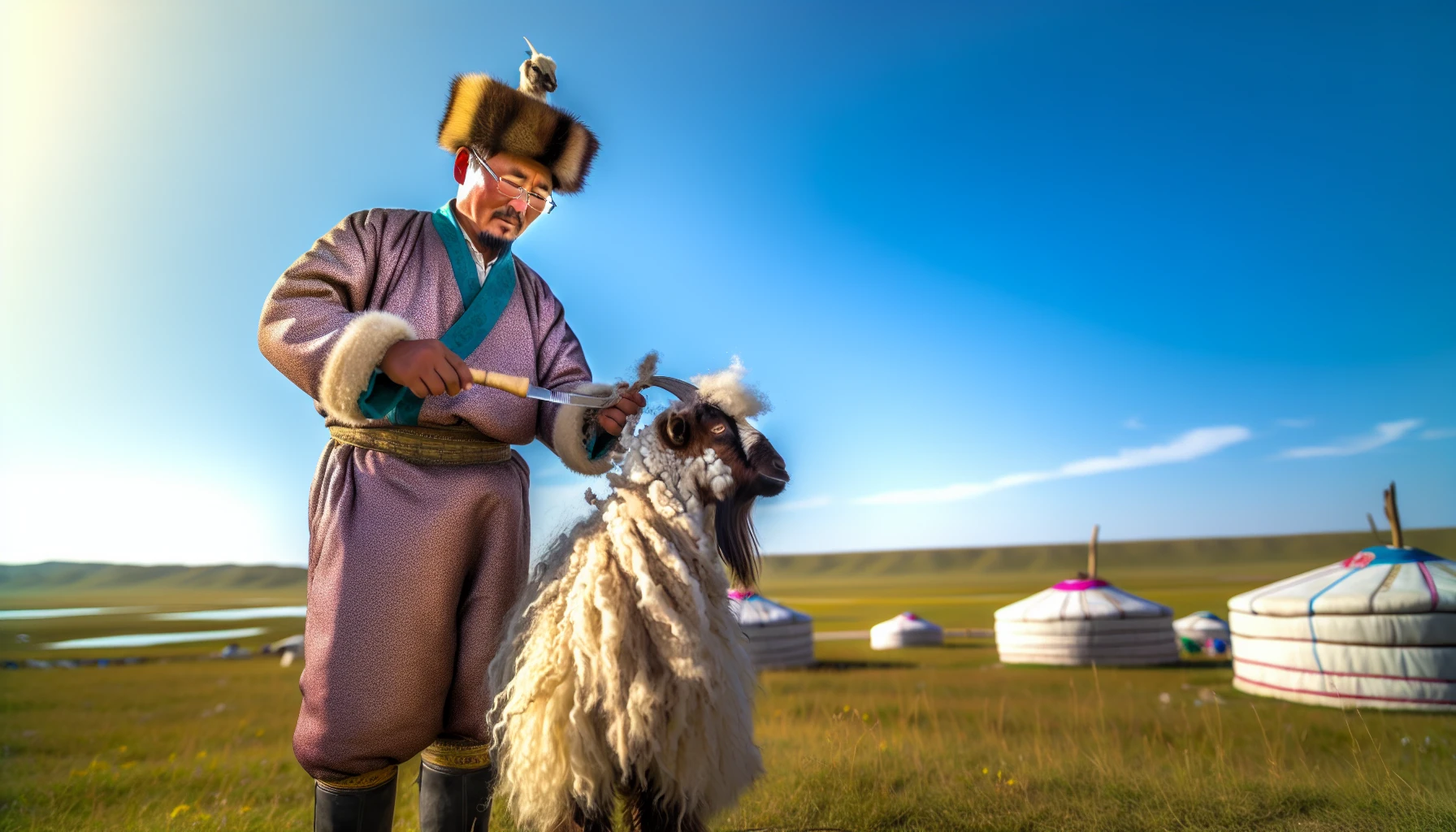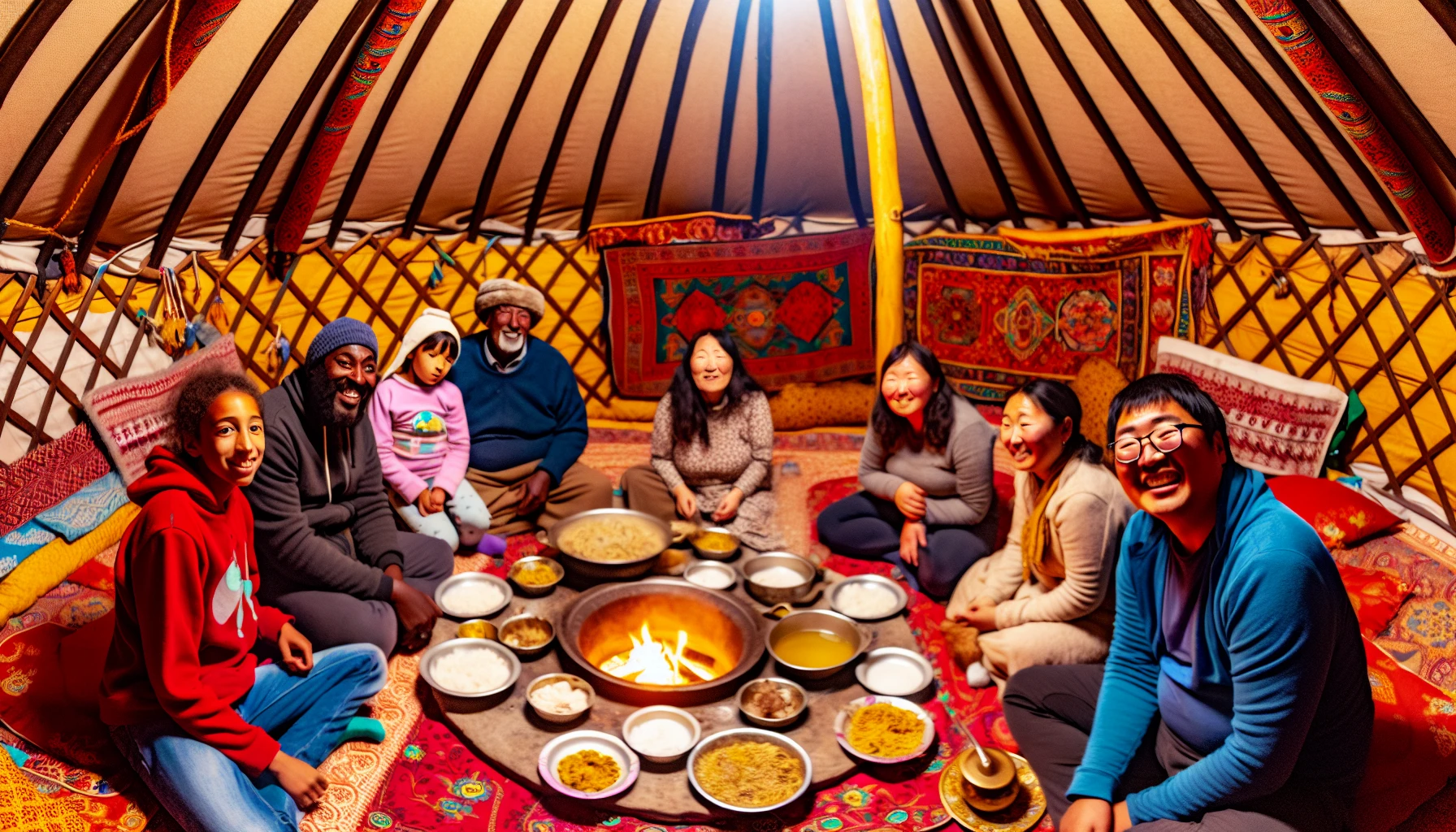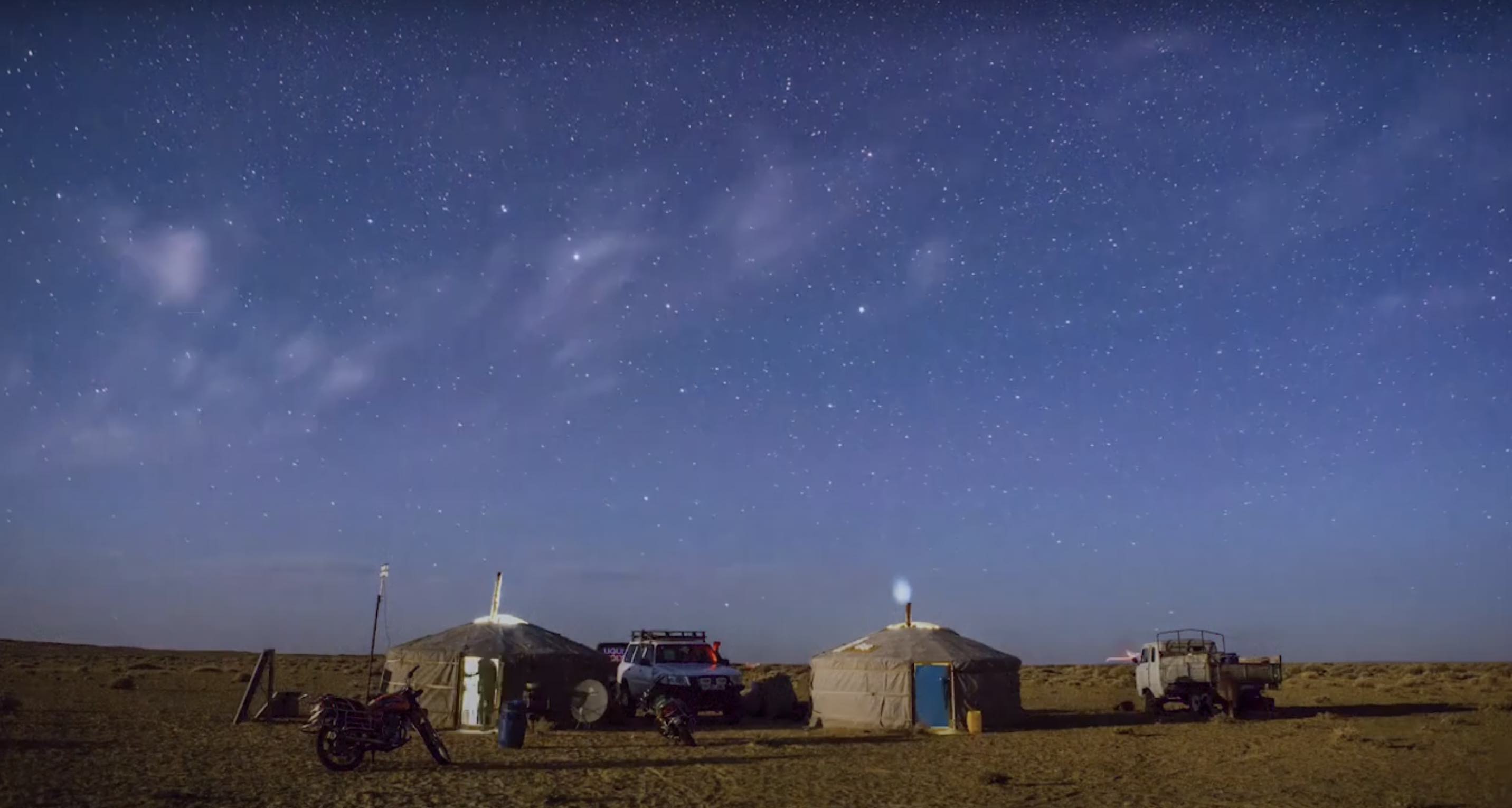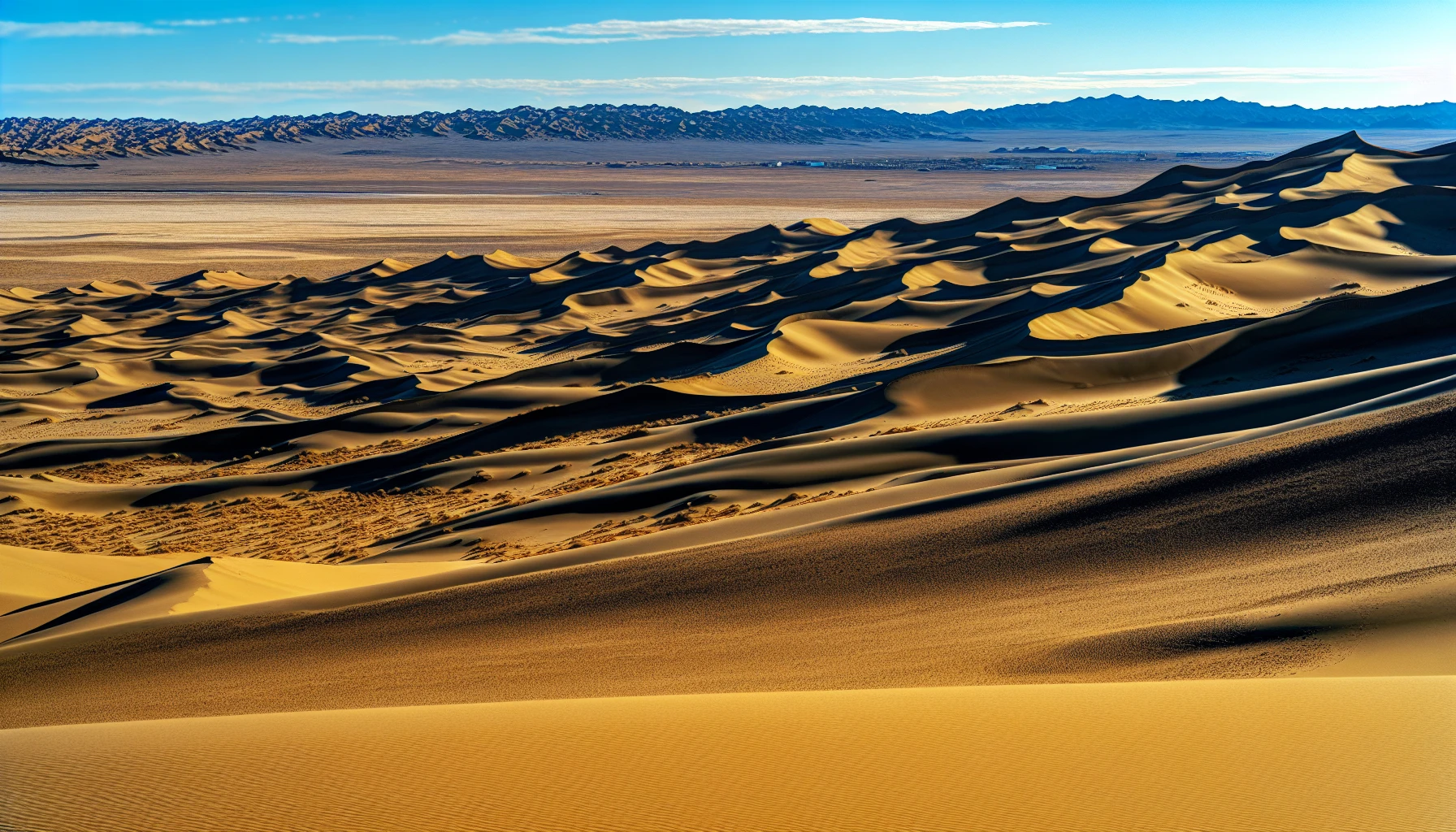Visiting a Mongolian Nomadic family
Contact us for travel suggestions
Visiting a Mongolian Nomadic Family: An Authentic Steppe Experience
Imagine stepping into a world where time has stood still and cultural traditions remain untouched by modern influences. A world where you can immerse yourself in the daily life of a Mongolian nomadic family, surrounded by breathtaking landscapes and experiencing the warmth of their hospitality. This authentic adventure awaits you as you embark on a journey to the heart of Mongolia’s vast steppes and experience visiting a Mongolian nomadic family first-hand.
Key Takeaways
- Visiting a Mongolian nomadic family provides an immersive experience of their daily life, including herding animals and engaging in traditional crafts.
- Respectful behavior is essential for gaining an authentic understanding of Mongolian culture. Gift-giving is a meaningful way to express appreciation for hospitality.
- Health and safety should be taken into consideration when planning your visit, by receiving recommended vaccinations and dressing appropriately for the temperature.
Experiencing the Daily Life of a Mongolian Nomad
Visiting a Mongolian nomadic family offers a truly authentic experience, where you’ll have the opportunity to participate in various aspects of their daily life. Some activities you can engage in include:
- Herding animals
- Learning traditional crafts
- Engaging in daily chores
- Sharing a traditional meal
By participating in these activities, you’ll gain a deeper understanding of the nomadic lifestyle that has persevered for centuries.
Herding Animals
Herding animals is a central element of the Mongolian nomadic lifestyle, with families relying heavily on their livestock for sustenance, clothing, and a source of revenue. The types of animals typically herded in Mongolia include horses, various goat breeds, camels, cows, sheep, and occasionally yaks, with some herders even raising Australian cashmere goats.

Traditional herding techniques play a significant role in the care and management of these animals. Some common practices among Mongolian herders include:
- Daily relocation of herds to disparate pastures
- Allowing the animals to select their own sustenance
- Different family members possessing distinct roles in the herding process
- Engaging herding dogs in moving and guarding the animals
Seasonal factors, such as the birthing season and harsh winters, can impact herding in Mongolia, making spring the most challenging time for herders.
Combing the cashmere goats and milking the cows and horses

Cashmere goats, including the Australian cashmere goat, the Inner Mongolia cashmere goat, the Liaoning cashmere goat, and the Mongolia cashmere goat, are of particular importance in Mongolia, as their luxurious cashmere fiber is highly sought after worldwide. The process to produce cashmere from these goats, such as the cashmere goat, involves manually combing them to extract the loose undercoat hairs, which constitutes the cashmere. Mongolian herders prefer hand-combing the goats instead of using mechanical shearing machines, typically combing them between April and early June. Cashmere production holds considerable economic and social value in Mongolian culture, with the cashmere wool sector sustaining approximately a million nomadic herders. It is important to note that average cashmere percentages can vary among different breeds of cashmere goats, as reported by the cashmere goat association.
Beyond combing cashmere goats, milking cows, horses, and even the occasional baby goat is a significant task for nomadic families, including those who tend to the Tibetan plateau goat. The milk from these animals is primarily used for producing fermented horse milk, known as airag. Milking horses is only possible during the summer months, ranging from July until late September. Horses, in particular, are symbols of freedom, strength, and vitality, embodying the spirit of the Mongolian people, and remain a key part of the national cuisine.
Traditional Crafts and Skills

While staying with a Mongolian nomadic family, you’ll get to observe and learn numerous traditional crafts and skills. From wood carving and silver chasing to the traditional method of producing felt, these crafts serve as important forms of artistic expression and craftsmanship, preserving the cultural heritage of Mongolia.
You may also have the opportunity to witness traditional Mongolian horse training, a hands-on approach that focuses on establishing a strong bond between the horse and the trainer, emphasizing trust, respect, and communication.
Participating in Daily Chores
You cannot fully comprehend the nomadic life without participating in daily chores. By assisting with tasks such as:
- herding livestock
- milking cows and goats
- collecting water and dung for fuel
- making dairy products
You’ll gain a more profound comprehension of the nomadic way of life and the strong connection between nomads and their animals.
This tangible involvement also provides insights into the resourcefulness and fortitude needed to live in a continually fluctuating environment.
Riding the horses
For Mongolian nomads, horse riding is a necessary means of transport and a favored activity among visitors. The Mongolian horse is a symbol of the nation’s culture, and their unique semi-wild training method allows them to adapt to the harsh environment of the steppes.
By learning to ride these magnificent animals, you’ll be able to experience an integral aspect of the Mongolian nomadic lifestyle and further connect with their rich culture.
Cooking and sharing a traditional Mongolian Meal

Your visit to a Mongolian nomadic family will not be complete without participating in cooking and sharing a traditional Mongolian meal. From steamed dumplings filled with minced mutton or beef (buuz) to fried meat pastry (khuushuur), and even boiled meat dishes, you’ll have the opportunity to taste the unique flavors of Mongolian cuisine.
Sharing a meal with your hosts allows you to not only savor the delicious food but also to bond over a common activity and appreciate the culinary traditions of Mongolia.
Sleeping in a Yurt and learning about its architecture
Staying in a traditional Mongolian yurt, or ger, gives you a glimpse into the traditional architecture and living conditions of Mongolian nomads. Constructed from a wooden frame covered in felt, the interior of a ger is typically cozy and can contain:
- beds
- tables
- chairs
- stools

By experiencing life in a ger, you’ll gain a deeper understanding of the nomadic way of living and appreciate the architectural ingenuity that has allowed these unique dwellings to endure for centuries.
The Beauty of the Mongolian Landscape

Mongolia’s landscape showcases a range of diverse and stunning vistas. Some of the highlights include:
- The vast rolling steppes, home to the iconic Mongolian horse and the threatened Przewalski’s horse
- The arid Gobi Desert with its intricate sand ecosystem
- The lush mountains and forests teeming with flora and fauna
There is no shortage of natural beauty to be found in Mongolia.
The diverse landscapes provide unique environments for nomadic families and an unforgettable backdrop for your visit.
Rolling Steppes
Mongolia’s rolling steppes, which serve as extensive grazing lands for the nomadic herds, are a distinctive aspect of the country’s landscape. These expansive grasslands, undulating hills, and unique biodiversity create a picturesque and serene environment for both the nomadic families and the visitors who come to experience their way of life.
Gobi Desert
The Gobi Desert presents a distinct and contrasting habitat for nomadic families. Its features include:
- Arid climate
- Sparse vegetation
- Towering dunes
- Ever-changing weather conditions
These characteristics create a mesmerizing view in the desert.
Despite the harsh conditions, nomadic families have adapted to life in the desert, relying on their resourcefulness and ancient herding techniques to sustain their livelihoods.
Mountains and Forests
The mountains and forests of Mongolia constitute a rich and varied home for both nomadic families and wildlife. The primary mountain ranges in Mongolia, such as the Mongol Altai, Khangai, and Khentii, support a rich variety of plant and animal species. In the forests, one can find unique flora such as bridlegrass, needlegrass, Mongolian chives, and the saxaul tree, as well as rare and endangered fauna like snow leopards, Siberian ibex, and argali sheep.
These natural landscapes offer a vibrant and thriving backdrop for the nomadic way of life.
Seasonal Activities and Celebrations
Year-round, Mongolia hosts a variety of seasonal activities and festivities, offering visitors unique cultural experiences. From the exhilarating Naadam Festival, showcasing traditional sports such as horse racing, wrestling, and archery, to the Lunar New Year, or Tsagaan Sar, marked by feasting and traditional rituals, these events offer a glimpse into the rich cultural heritage of Mongolia.
Naadam Festival
The Naadam Festival is a significant event in Mongolia, held yearly from July 11 to 13. This national festival displays the “Three Manly Games”: horseracing, wrestling, and archery. The festival is profoundly connected to Mongolian culture and heritage, commemorating their ancestors and traditions while reviving the nomadic spirit.
By attending the Naadam Festival, you’ll be able to witness firsthand the incredible athleticism and skill of the Mongolian people while gaining an appreciation for their rich history and cultural traditions.
Lunar New Year (Tsagaan Sar)
The Lunar New Year, also known as Tsagaan Sar, is a significant festivity for Mongolian families. Marking the beginning of the lunar new year, it is a time for family reunions, feasting, and performing traditional rituals. During the celebration, families prepare traditional dishes such as buuz (steamed dumplings) and khuushuur (fried meat pastry), while also exchanging greetings and offering wishes of prosperity and health.
Experiencing Tsagaan Sar provides a unique opportunity to engage with the customs and traditions of Mongolian culture.
Seasonal Migrations
Seasonal migrations, due to which families move their herds to new pastures for superior grazing conditions, are an integral component of nomadic life in Mongolia. Factors such as climate change, extreme weather conditions, and the necessity of finding suitable pasturelands initiate these migrations.
By witnessing and understanding the seasonal migrations of Mongolian nomads, you’ll gain a deeper appreciation for the challenges they face and the resilience they demonstrate in maintaining their traditional way of life.
Tips for a Successful and Respectful Visit
For a successful and respectful visit to a Mongolian nomadic family, you should familiarize yourself with local customs, practice effective communication, and adhere to necessary health and safety precautions. By doing so, you’ll be able to fully immerse yourself in the nomadic lifestyle and gain a deeper understanding of Mongolian culture.
Communication
Mastering basic Mongolian phrases and understanding non-verbal cues can help overcome language barriers, leading to a more enjoyable visit. Some useful phrases to learn include greetings such as ‘Sain baina uu?’ (Greetings, how are you?) and ‘Sain baitsgaan uu?’ (Greetings to all).
Being aware of non-verbal cues, such as eye contact and gestures, can also enhance your communication with your hosts and provide a more immersive experience.
Health and Safety
Adopting suitable health and safety measures is crucial for a comfortable and pleasurable visit. Ensure that you receive recommended vaccinations, such as Hepatitis A, Typhoid, Rabies, and Japanese Encephalitis. Additionally, be prepared for temperature extremes, especially during the winter season, by dressing in layers and wearing warm clothing.
In the summer, remain hydrated and wear lightweight, breathable clothing to cope with the heat.
Responsible Tourism
Responsible tourism entails respecting local customs, reducing your environmental footprint, and backing local communities. It is important to be aware of and adhere to Mongolian customs, such as proper greetings and table manners, as well as understanding the importance of gift giving in their culture.
By engaging in responsible tourism practices, you’ll be able to fully appreciate the nomadic lifestyle while ensuring that your visit has a positive impact on both the environment and the local community.
Preparing for Your Nomadic Family Visit
In preparation for your visit to a Mongolian nomadic family, you should acquaint yourself with cultural norms and etiquette, and think about suitable gifts for your hosts. By doing so, you’ll be able to fully engage with the nomadic lifestyle and show appreciation for the hospitality of your hosts.
Cultural Norms and Etiquette
Acquainting yourself with Mongolian cultural norms and etiquette is critical for a respectful visit. Be mindful of proper greetings, table manners, and other customs, such as not leaning against or passing between the central pillars of a yurt.
By observing these customs and showing respect for your hosts, you’ll be able to fully experience the nomadic lifestyle and gain a deeper understanding of Mongolian culture.
Gift Ideas
Bringing small gifts for your hosts is a thoughtful gesture to show appreciation for their hospitality. Consider practical items for the family, such as:
- small pocket knives or multi-tools
- handkerchiefs
- woolly hats or socks
- small torches
Toys for children, such as traditional anklebone games or homemade toys crafted from items found around the home, are also appreciated. By offering these gifts, you’ll be able to demonstrate your gratitude and further connect with your hosts.
Summary
Visiting a Mongolian nomadic family offers a unique and unforgettable experience, providing a firsthand glimpse into a rich culture and way of life that has withstood the test of time. From participating in daily chores and experiencing traditional crafts to witnessing the breathtaking landscapes and engaging in seasonal activities and celebrations, you’ll be able to fully immerse yourself in the world of the Mongolian nomads. So, why not embark on this enriching journey and discover a world unlike any other?
Frequently Asked Questions
What are some rules for visiting inside of a ger?
When visiting a ger, it is important to be respectful and courteous, take off your shoes when entering, ensure that you keep the space clean, and not disturb the inhabitants. Additionally, always ask for permission before taking photos or videos.
Can you live with Mongolian nomads?
You can live with Mongolian nomads if you are open to a hands-on experience which involves herding, milking and helping the family catch horses. Your accommodation will be in a traditional Mongolian hut and your hosts will be eager to share their customs with you.
What are the nomadic traditions in Mongolia?
Mongolia is home to a unique nomadic tradition which sees pastoralists moving seasonally with their five main livestock – goats, sheep, cattle, camels and horses – in search of the best pastures and campsites.
Are there still nomadic Mongolians?
Yes, there are still nomadic Mongolians living as herders in remote locations away from villages and towns. Up to 40 percent of Mongolians live this way, with limited access to electricity.
What types of animals do Mongolian nomads typically herd?
Mongolian nomads typically herd horses, goats, camels, cows, sheep and yaks, with some keeping Australian cashmere goats.
 Visiting a Mongolian Nomadic Family
Visiting a Mongolian Nomadic Family